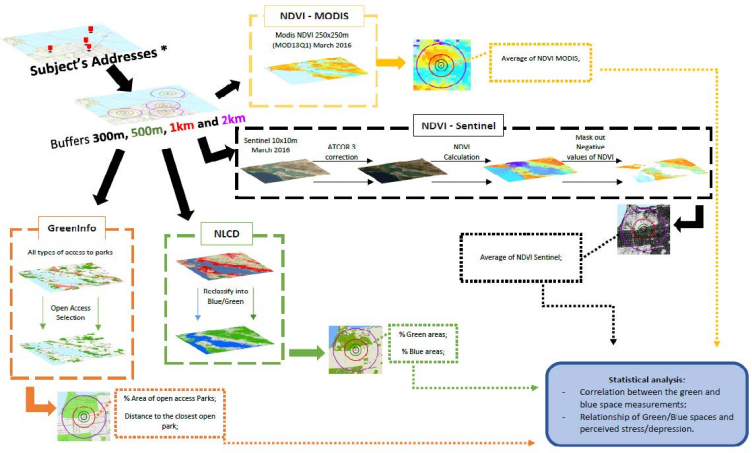Urban greenspace, bluespace, stress, and depression during pregnancy: San Francisco Bay Area

Abstract
This research explores the relationship between environmental factors and mental health, more precisely, the connection between vegetation (‘greenspace’), water bodies (‘bluespace’), and how they relate to perceived stress and depression during pregnancy. Questionnaires about mental health were collected from 824 pregnant women in the greater San Francisco Bay Area of California and analyzed in the context of the proximity of their residences to greenspace and bluespace. I used four different datasets to calculate greenspace, including one vector and three raster sets: GreenInfo network (vector), National Land Cover Database (NLCD), Normalize Vegetation Index (NDVI) MODIS, and NDVI Sentinel. Bluespace was calculated using only the land cover dataset. I measured the distance to the closest open access park, the percentage of green and blue areas within four Euclidean buffers (300m, 500m, 1km, and 2km), and the average NDVI within the same buffers distances. In order to test the hypothesis that blue and green space are associated with mental health, I calculated Spearman’s correlation coefficients, compared average green and bluespace measures across two sub-groups (low vs. high scores for perceived stress and depression), and the average perceived stress and depression scores across categorical greenspace quartiles. From the Spearman’s correlation, greenspace was in general negatively correlated with depression (rho between -0.11 and 0.03 depending on the greenspace measure) and stress (between -0.06 and 0.02). Women with low levels of perceived stress and depression had higher averagelevels of greenspace, where it had strong association observed with NLCD, MODIS and Sentinelgreenspace measures. For bluespace, women with low levels of perceived stress and depression had higher average levels of bluespace, within all NLCD buffers; however, the majority of significance of bluespace was with perceived stress outcomes. NDVI and NLCD datasetspresented a more significant result than the vector dataset (GreenInfo Network); the differencebetween raster resolutions did not appear to be significant. In the categorical greenspace quantile analysis, greenspace was more significant for depression than for perceived stress. In conclusion,this study found significant connections between mental health and residential proximity to green and blue spaces. Further research is needed to consider distance to green/bluespace as streetnetwork analysis, different approaches to calculate the environmental quality and analysisincluding socio-economic factors.